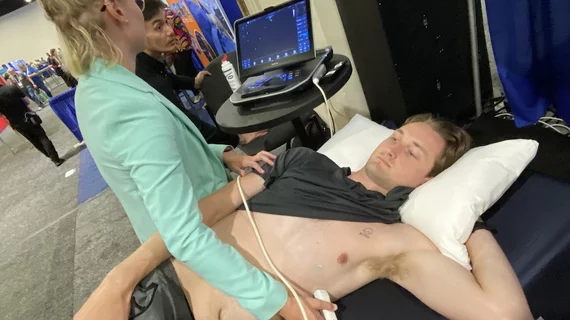Stretching may help reduce painful orthopedic issues among echo and interventional lab staff
The biggest work-related injury in cardiology are orthopedic issues related bending and twisting in odd positions over a patient during cardiac ultrasound exams. made worse when wearing heavy lead aprons during cath lab and electrophysiology (EP) procedures. Over time, the back pain can become debilitating and can lead to early retirement.
A new pilot study from Mayo Clinic published in the Journal of the Society for Cardiovascular Angiography and Interventions (SCAI) looked at how stretching improves range of motion and changes the elastic properties of muscle-tendon units. Researchers said it may help overcome upper extremity musculoskeletal disability of employees.[1]
"We hypothesized that a regular stretching program would reduce the functional consequences of pain for employees working in echocardiographic, ultrasound, and interventional laboratories. This exploratory, proof-of-concept study was meant to inform expectations for future randomized, controlled studies," explained lead author Russell Gelfman, MD, and colleagues in the study. "We found a routine stretching program may represent an attractive, low-cost, noninvasive option to reduce upper extremity musculoskeletal disability of employees working in the echocardiographic, ultrasound, and interventional laboratories. Larger randomized trials are needed to confirm the association."
Gelfman, a neuromuscular disease specialist whose research includes work-related musculoskeletal disorders, teamed up with echocardiographers and interventional cardiologists at Mayo to conduct the study. They enrolled 196 healthcare professionals working in the interventional and echo laboratories in the departments of cardiology and radiology at Mayo Clinic to perform a 15-minute neck, upper extremity, low back, and lower extremity stretches for one year. The functional consequences of pain were self-reported by using the Disability of Arm, Shoulder, and Hand index, Neck Disability Index, and the Roland-Morris Questionnaire, which was administered at baseline and at one year to measure response to stretching. Monitoring with an assessment plan for injuries was undertaken. Employees who were pregnant, unable to do exercises, or under active orthopedic treatment, were excluded.
Of the 196 employees enrolled, 68 (35%) provided complete data at both baseline and follow-up. The majority of participants were over 40 years (72%) and female (72%). Participants performed stretches for 120.5 days over the year. The majority of participants (52.3%) stretched before, 18.9% stretched during and 28.8% stretched after work. Self-reported upper extremity disability improved in the treatment group with a significant decrease in the median Disability of Arm, Shoulder, and Hand score (5.2 to 2.6).
The researchers said this was an absolute 4% decrease in the Neck Disability Index score, between baseline and 1-year follow-up. There was not a significant change in the Roland-Morris Questionnaire from baseline to follow-up (1 to 0). No participant reported any stretch-related injuries.
Incidence of musculoskeletal pain among healthcare workers
The study researchers said musculoskeletal pain is prevalent among healthcare workers and may be due to a combination of stress, overexertion and awkward and prolonged postures. They said repeated exposures and demands of activities can overload and exceed the threshold of tolerable stress, resulting in musculoskeletal pain. In a previous multi-site Mayo Clinic study that involved physicians and allied health staff, 55% of personnel working in radiology and cardiology departments reported musculoskeletal pain, 30% sought medical care for pain, and 29% had pain at the time of the study.[2]
Despite being younger and having worked for fewer years, a higher number of technicians and nurses reported work-related musculoskeletal pain versus a control group.
Addressing the high prevalence of musculoskeletal pain presents an opportunity to improve the work-related health of employees, the researchers explained. The interventions introduced in this study were no-cost, minimal-risk and have the potentially to reduce musculoskeletal discomfort that did not require any special equipment or monitoring. The stretches could be performed any time of the day at the convenience of the employees working in the catheterization, echocardiographic, or radiology laboratories. The study intervention was designed by a physical therapist who instructed the intervention in detail to study participants.

